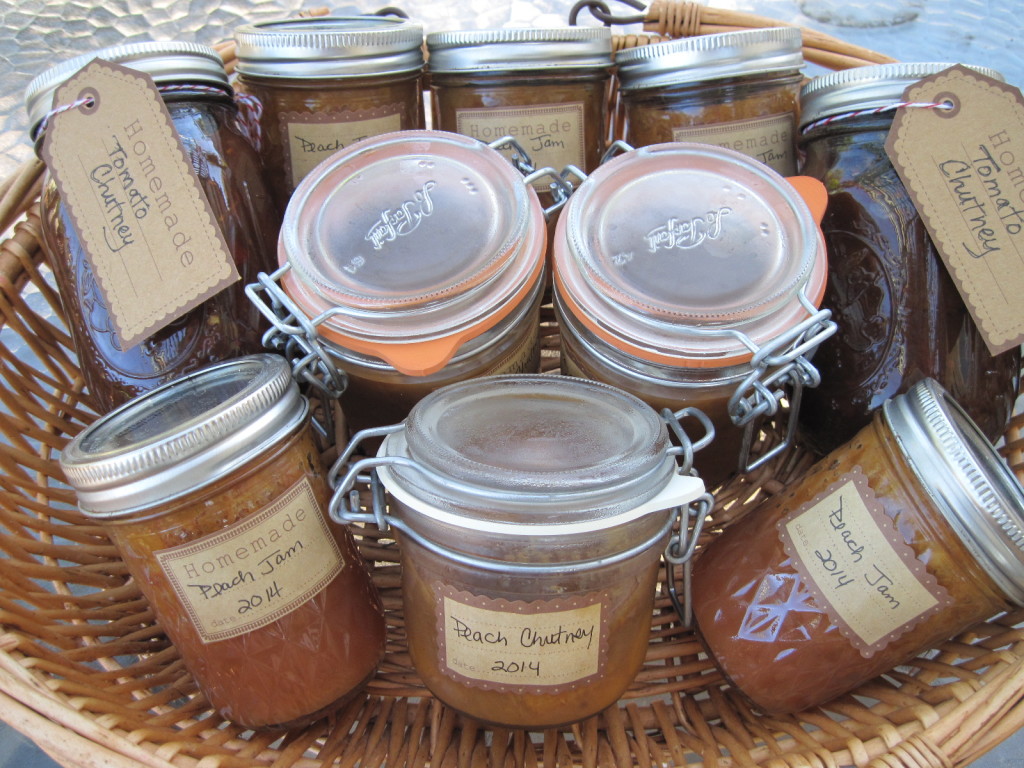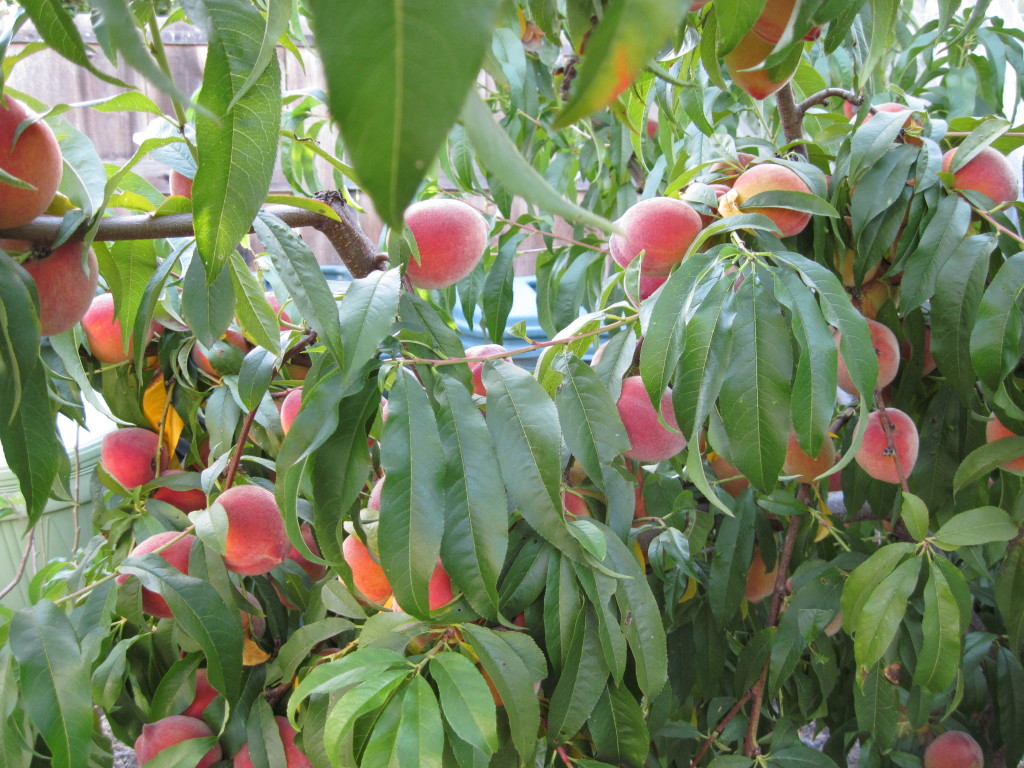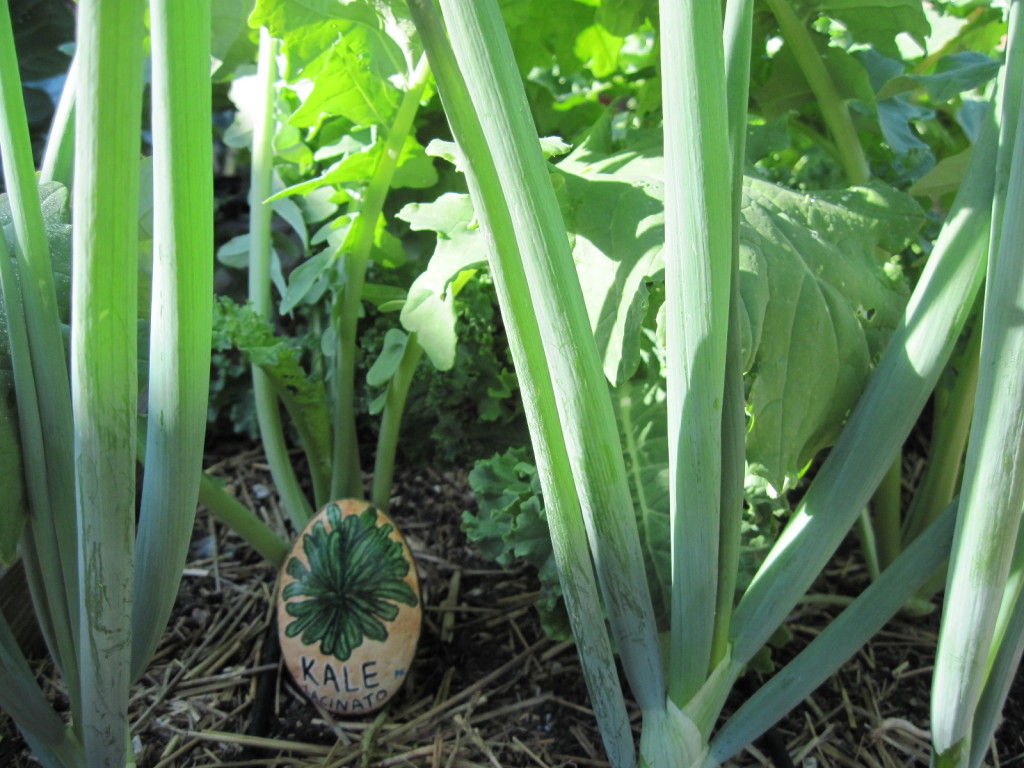When a new client here in the North County San Diego area asks us to help them create an edible garden, I often ask “How long are you willing to spend in your garden each week?” Responses range from a few minutes to a few hours. Many people want the freshness of edible gardens without substantial time commitment since their lives are already busy. When clients taste a peach picked fresh from a tree (or tomatoes, salad greens, berries, you name it), however, they can’t say enough about how wonderful it tastes! So if they are that excited about eating freshly-picked vegetables and fruits, what might inspire them to spend more time growing their own? And how do we help them create their own successful edible gardens that provide abundance without adding significant time commitment on their part?
As I pondered that question, I wondered if we shouldn’t rethink how we spend our time bringing edibles to our tables. Maybe we should consider using more gardening techniques that if performed up front, will save us time over the growing season; or plant certain edibles that don’t require a lot of maintenance. Also, shouldn’t we consider the time saved by shopping at our “fresher than local neighborhood market” when considering the time spent growing our edibles?
In the years of growing year-round edible gardens I have experimented with many varieties of edibles and through my successes and mistakes have developed the following techniques that have saved me significant amounts of time and effort. Before I share these tips with you, I recommend that you start small. This is not a new concept, but worth repeating. If you are new to edible gardening, plant one small bed of greens or an herb garden that provides fresh salads or seasonings for soups or stews. Once you have some success, then expand a little more, then a little more, until you reach the garden size you desire.

1. Take Time to Prepare the Soil – Whether your are planting in your garden soil, raised beds, or in pots, take time to properly prepare the soil. Your plants will be much happier and require much less attention if you start them off in good soil. When I first started growing edibles, I was so excited to get started so I just dug holes, added some fertilizer, planted the edibles, and watered them. Sometimes I had good success, but usually my plants struggled and sometimes died. I spent much more time trying to make the plants grow better in the less than optimal soil than I would have had I taken time up front to prepare the soil. My favorite ways for building soil and providing the nutrients for my organic garden include the uses of compost, worm castings, cover crops, and aerated worm teas, supplemented with a small amount of organic fertilizers.
2. Include drip irrigation or use another low-water method to irrigate your edible garden beds – Growing edibles in our home gardens still makes sense in our drought when you consider that drip irrigation systems, particularly when combined with mulch, result in less water evaporation than overhead sprayers often used by commercial growers. Additionally, in the garden-to-table system produce is handled fewer times, thus reducing the number of times it needs to be rinsed. Spending the time up front to set up an irrigation system will save you time in maintaining your edible garden and allow you to go on vacation while your edibles grow. I use a combination of drip irrigation and ollas or unglazed clay pots, that deliver water directly to the roots of plants, to water my edible garden and apply a deep layer of mulch around my edible crops and fruit trees to keep the soil microbes happy.
 3. Plant greens and vegetables that do really well for your climate and require little time to maintain – Here in the San Diego area I have found a number of edibles that either act as a perennial or are easy to grow and don’t take a lot of time to maintain. Certain greens like Swiss chard, collards and kale can last in the garden for several months, so once established, require minimal care and provide almost a daily supply of greens. Rustic arugula acts as a perennial in my garden and cutting it back a few times each year encourages tender new growth that can be used to spice up your salads. Another edible that I find easy to grow is sweet potatoes. They are a wonderful ground cover that looks lovely in a front yard garden and can even be a perennial in our mild climate. I first planted them four years ago and find them to be very easy to grow in my garden and so tasty. I harvest them every fall and watch the roots come back again by early spring that provides another crop of sweet potatoes again the next fall.
3. Plant greens and vegetables that do really well for your climate and require little time to maintain – Here in the San Diego area I have found a number of edibles that either act as a perennial or are easy to grow and don’t take a lot of time to maintain. Certain greens like Swiss chard, collards and kale can last in the garden for several months, so once established, require minimal care and provide almost a daily supply of greens. Rustic arugula acts as a perennial in my garden and cutting it back a few times each year encourages tender new growth that can be used to spice up your salads. Another edible that I find easy to grow is sweet potatoes. They are a wonderful ground cover that looks lovely in a front yard garden and can even be a perennial in our mild climate. I first planted them four years ago and find them to be very easy to grow in my garden and so tasty. I harvest them every fall and watch the roots come back again by early spring that provides another crop of sweet potatoes again the next fall.
4. Plant your favorite fruit trees that do well in your climate by incorporating them into your existing landscapes – Figs and pomegranates do so well in our climate and require less water than other fruits. I also find that by deep watering once every few weeks and providing deep mulch around fruit trees, we have an abundance of fruit throughout the year.
 So,…try a few of these tips to get your edible garden to a great start. And instead of taking your shopping list to the store, take that shopping list to your garden, pantry, or freezer. Stop at your doorstep to pick a few sprigs of herbs for your stir-fry on the way to your garden beds to pick some cherry tomatoes, basil, and bell peppers. In the winter, “shop” for sun-dried tomatoes, winter squash, sweet potatoes, and herbs for your soups or stews. And don’t forget to open a jar of peach preserves on a cold Winter morning for that taste of “Summer”.
So,…try a few of these tips to get your edible garden to a great start. And instead of taking your shopping list to the store, take that shopping list to your garden, pantry, or freezer. Stop at your doorstep to pick a few sprigs of herbs for your stir-fry on the way to your garden beds to pick some cherry tomatoes, basil, and bell peppers. In the winter, “shop” for sun-dried tomatoes, winter squash, sweet potatoes, and herbs for your soups or stews. And don’t forget to open a jar of peach preserves on a cold Winter morning for that taste of “Summer”.
Now that you are inspired to create your super local market, what is stopping you? The time to start growing edibles is today! See our Services page for how we can help.

